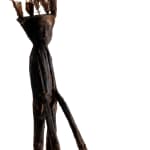 Oracle figure (kafigelejo)
Oracle figure (kafigelejo)
 Oracle figure (kafigelejo)
Oracle figure (kafigelejo)
 Oracle figure (kafigelejo)
Oracle figure (kafigelejo)
 Oracle figure (kafigelejo)
Oracle figure (kafigelejo)
 Resume your flesh and form XI, Beatrice Wanjiku
Resume your flesh and form XI, Beatrice Wanjiku
Anonymous Senufo artist
origin: Ivory Coast - early 20th century
37 1/8 x 6 1/4 x 5 1/2 in
Further images
A hybrid creation that lies outside the realm of anything recognizable in nature, this Senufo oracle figure deliberately provokes anxiety through its shrouded anonymity and the sense of suffocation and entrapment it suggests. Such works and the ritual practice in which they were used were both known as kafigeledjo ("he who speaks the truth").
The figure represents an invisible bush spirit and was used during divination practices. Kafigeledjo divination was used to uncover misdeeds, false testimony, and culpability. This pursuit of truth ultimately soke to preserve and uphold Senufo social guidelines. It did so by unveiling illicit behavior and by punishing with supernatural sanctions those who violated rules pertaining to forbidden sexual relations and exogamous marriage. In essence, a wild force was thus subdued and harnessed through the kafigeledjo as a means for unveiling and punishing transgressions.
Although such works have the potential to affect all members of a Senufo community, access to this oracle figure was restricted to the most senior male and, occasionally, female members, who kept it shrouded in secrecy. In order to harness its power and operate it successfully, the figure received ritual sacrifices, which unevenly cover its surface with crusty matter. A loosely fitting bodysuit made of a coarse fiber textile exposes only the feet of the figural representation within. Above the neck – where the garment is cinched tightly by a cord – the cloth flares out in an inverted cone. The figure’s head is crowned by a row of feathers. The effect of engulfing the figure in a textile sack blurs the boundaries between material and immaterial, playing with the ambiguity between obscured and revealed form.
No documentation exists to provide information of how such works were operated during divinations sessions. The significance of its appearance as well remains unknown. Embodying a wild and unsettling anti-aesthetic, it should be no surprise this enigmatic figure was once owned by the French artist Arman, who at one point possessed five other kafigeledjo (cf. "African Faces, African Figures. The Arman Collection", New York, The Museum of African Art, 1997, #13).
Provenance
Collection Vittorio Mangio , Monza, Italy
Collection Corice & Armand Arman, New York, USA
Maureen Zarember – Tambaran Gallery, New York, USA
Luciano & Christina Lanfranchi collection, Milan, Italy
Private collection, Belgium
let's keep in touch
Join our community & never miss out on a DUENDE moment from now on
* denotes required fields
We will process the personal data you have supplied to communicate with you in accordance with our Privacy Policy. You can unsubscribe or change your preferences at any time by clicking the link in our emails.




